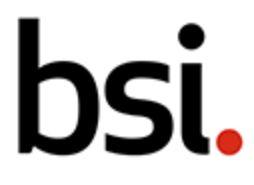Standard 1
Please be advised that a New Work Item Proposal has been loaded to the BSI Standards Development Portal for comment.
Any comments received will be submitted to the national committee AMT/4 “Industrial Data and manufacturing interfaces” for consideration when deciding the UK response to the associated Standards Development Organisation.
Proposal: ISO/NP 16400-5 Automation systems and integration — Equipment behaviour catalogues for virtual production system — Part 5: Part 5: Integration of EBC templates in production system design and operation
Please visit http://standardsdevelopment.bsigroup.com/projects/9022-07938
Comment period end date: 29/01/2023
Scope
This document specifies interfaces of equipment behaviour catalogues (EBCs) to production system design and operation thus providing technical and contextual information for integration
Purpose
ISO 16400 provides an equipment model, which contains information about equipment properties as well as equipment behaviours such as state transitions and operation results stemming from the machines’ activities. The widespread usage of simulation systems for forecasting performance, manufacturability and productivity demonstrates the need of liable and seamless data acquisition at any given point of interest within the products’ lifecycle. Focussing on the manufacturing equipment provides a bridge between production planning and manufacturing in the shop floor enabling data exchange and interfacing of information from the machine to MES and higher aggregating systems. In this part of the 16400 series, EBC templates are placed in the context of production system design and operation. This process will include the main information objects such as equipment, device, production units, as well as operations, process steps and plans, costs and order. The purpose of the embedding is to provide a seamless, standardized information and data exchange model in a semantic context thus supporting the data usage for use cases and user scenarios from various manufacturing domains.
Justification
An equipment vendor such as a machine tool maker and manufacturing device provider develops an EBC of his machine using a corresponding standardized template, or by following standardized methods and rules.
The addition of this part of the series ensures that EBC can interact with other complementary standards such as Automation ML (AML) or IEC 62264 in the wider context of virtual manufacturing ordering processes and virtual commissioning thus supporting the ramp-up of concepts such as cyberphysical systems or digital twins. It enables process / product owners, manufacturers and customers to interact virtually with each other in context of their individual use cases and derived requirements and thus extend the capability and accuracy of modern simulation systems in the result creation. It is expected that performance is increased, information gaps reduced and data exchange becomes more ubiquitous facilitating a better overall quality of virtual manufacturing as a whole.
Standard 2
Any comments received will be submitted to the national committee IST/33 “Information security, cybersecurity and privacy protection” for consideration when deciding the UK response to the associated Standards Development Organisation.
Proposal: ISO/IEC PWI TS 7709 Information technology — Big data security and privacy — Security and privacy-preserving guidelines for multi-sourced data processing
Please visit http://standardsdevelopment.bsigroup.com/projects/9022-07942
Comment period end date: 31/01/2023
Scope
This document provides security and privacy preserving guidelines for multi-sourced data processing, including a model for multi-sourced data processing, identifying the stakeholders, and identifying the security and privacy risks related to multi-sourced data processing, and a framework to mitigate the identified security and privacy risks with guidance on applying security and privacy controls.
Purpose
Compared to single-source data, processing multi-sourced data from different providers offer the ability to conduct correlated analysis on a richer data set, and more information can be extracted to guide decision-making in business operations, leading to better customer services. The variety of data from multiple sources may make the data processing more productive. ISO IEC TR 231862018 “Information technology – Cloud computing – Framework of trust for processing of multi-sourced data” describes scenarios of using multi-sourced data to reduce traffic deaths and injuries, for home automation, for automotive operations.
Meanwhile, there are security and privacy risks (such as data leakage, re-identification, data misuse, etc.) need to be mitigated during the data processing.
There have been series of standards about big data architecture, trust for multi-sourced data processing, security and privacy, etc. Some of them provide requirement statement, some of them provide high level framework, while how to guide the implementation and what kind of mechanisms are applicable on security and privacy regarding the specific scenario, that is multi-sourced data processing, is absent.
The stakeholders of multi-sourced data processing need standards as guidance and implement relevant technical solutions such as prevention of re-identification from multi-sourced data, authorization consistency checking and confirmation of multi-sourced data, etc. to ensure the data processing security and privacy-preserving. And the clear technical terms in the standard could reassure the stakeholders (data providers, service providers, end users, etc.) when sharing data. This proposal is intended to provide guidelines on how to mitigate the security and privacy risks in multi-sourced data processing scenarios and help to reassure the stakeholders in technical ways.
If you have any comment or need more information, please contact Sami Ortiz at [email protected]

